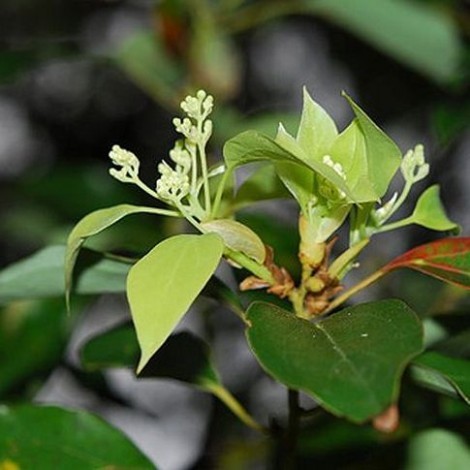Ho Leaf (Cinnamomum camphora CT linalool, Ho Sho)
Tomorrow sees me hobnobbing at the East India Club on St. James Square – ok, so maybe drinking tea with Hobnobs at the Club with my fellow graduates from the NYR Aromatherapy Diploma group. Having spent two years together sniffing essential oils, practicing massage techniques, cramming books, having our heads filled with anatomy & physiology, panicking over exams and laughing, talking and hugging we decided that post-grad support and love was still required and we formed a group that likes to meet every three months or so. At our last meeting we each elected to do some research on an essential oil and I chose Ho Leaf.
‘Ho Leaf, what’s that?’ is the common reaction of most people, clients, friends or anyone I mention it to.
Simply put, Ho Leaf is a relatively little known essential oil with a fairly recent history of use in Aromatherapy. It is worth me spending a little time describing the oil as there are various types, which can lead to some confusion. As well as Ho Leaf it may also be referred to as Ho Sho and is steam-distilled from the leaves of the Camphor Tree Cinnamomum camphor; although a more expensive oil may also be distilled from the wood – when it is known as Ho Wood. This is a tall, evergreen tree, native to Asia and cultivated in Japan, China and Taiwan. In fact, oils from the tree have long been used in traditional medicine, true Camphor and Ravensara, but these are actually different chemotypes and thus different oils – a chemotype being a species of plant which appears to be the same, but which has a substantially different chemical composition due to genetic differences.
Ho Leaf essential oil mainly contains the chemical l-linalool and so it’s important to ensure that you have the correct oil. The best way is to buy from a reputable source (suggestions given at the end of this blog) but you can tell yourself by checking the name on the label – ‘CT’ refers to the chemotype and for Ho Leaf you need to find the chemotype ‘Cinnamomum camphora CT linalool’. L-linalool is also one of the main chemicals found in Lavender  and Ho Leaf may be used in many similar ways.
and Ho Leaf may be used in many similar ways.
It can be summarised (as much as any oil can….) in four words: gentle, calming, uplifting, refreshing. An excellent anti-depressant, its profoundly calming properties make it a natural choice for stress-related conditions such as panic attacks, anxiety and palpitations – combine with peaceful Neroli and Clary Sage for immediate inhalation via an aromastick (think a Vicks Inhaler for essential oils) or with a few drops placed on a tissue. It is also indicated for conditions such as nervous exhaustion, or tension-related insomnia, fatigue and immunity support. For stress-related insomnia I would recommend combining with other calming and grounding oils such as Bergamot and Vetiver.
As a very gentle calmative with grounding but non-sedating properties Ho Leaf is said to balance the emotions and soothe the mind, which also makes it valuable for use in meditation blends. Yet with both antimicrobial and antiseptic properties it is also brilliant to use for warding off coughs and colds and for immunity support in general – particularly when you are feeling run down due to stress or tension. Think of it combining it with Ravensara essential oil or Echinacea tincture.
Highly refreshing, it is beautifully balanced for skincare and this is another of its main uses within Aromatherapy. It is said to assist in the regeneration of skin tissue and together with oils such as Ylang Ylang is used for balancing the skin. Thus it can be used to moisturise dry skin (think Ho Leaf, Frankincense & Rose), balance combination skin, reduce sebum in oily skin (try Ho Leaf, Geranium & Lemon) and its sweet, fresh slightly floral scent makes it a brilliant oil to calm spots and Acne without smelling too medicinal, I would suggest Ho Leaf & Palmarosa. I would also use it to treat inflammatory skin conditions such as Ezcema and Pruritus (itching skin) using blends such as Ho Leaf, Helichrysum & Chamomile (Roman Chamomile Anthemis nobilis for sensitive or German Chamomile Matricaria recutita for inflamed skin) – it’s gentle nature means that it can be safely used for those with either inflamed or sensitive skin.
Gentle, safe and highly affordable at £2.00 – £5.49 for a bottle – try this little known but beautiful oil to calm the mind and soothe the skin (and impress all around with your knowledge of the more exotic essential oils!
Recommended Suppliers
Neal’s Yard Remedies (organic), £5 for 10mls
http://www.nealsyardremedies.com/ho-leaf-essential-oil
Base Formula, £2 for 10mls
http://www.baseformula.com/product.php?xProd=6653
G Baldwin & Co, £5.49 for 10mls
http://www.baldwins.co.uk/aromatherapy/essential-oils/essential-oils/baldwins-ho-leaf-essential-oil/
Kobashi Aromatherapy (organic) £2.58 for 10mls
https://www.kobashi.co.uk/essentialoils/Ho_pure_essential_oil_Cinnamomum_camphora.html

